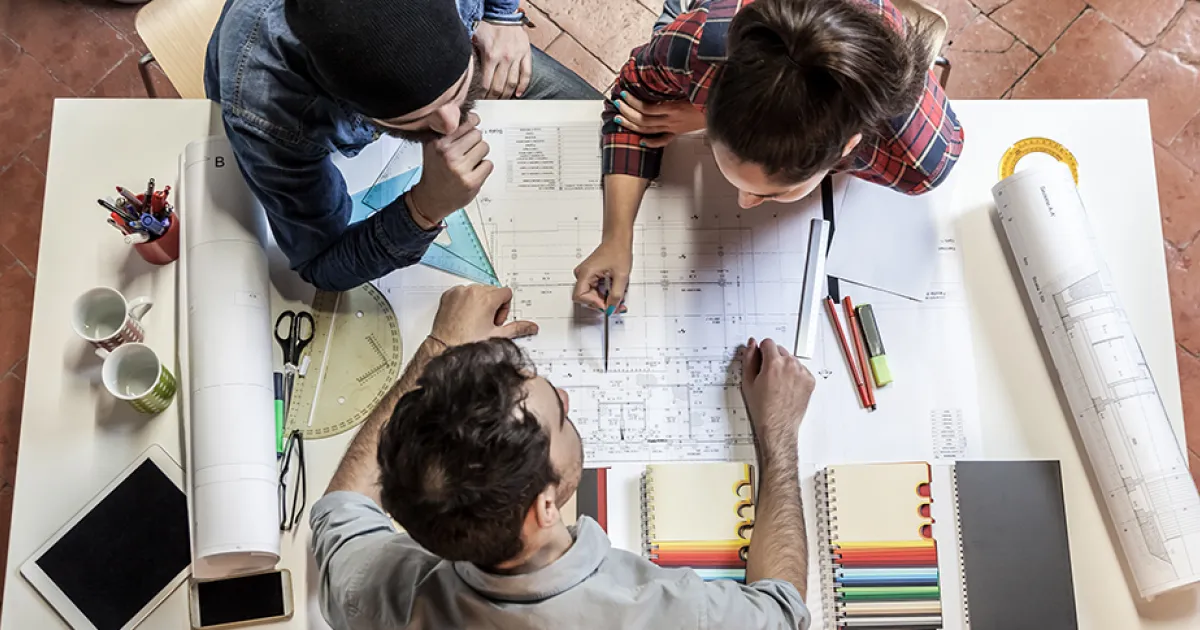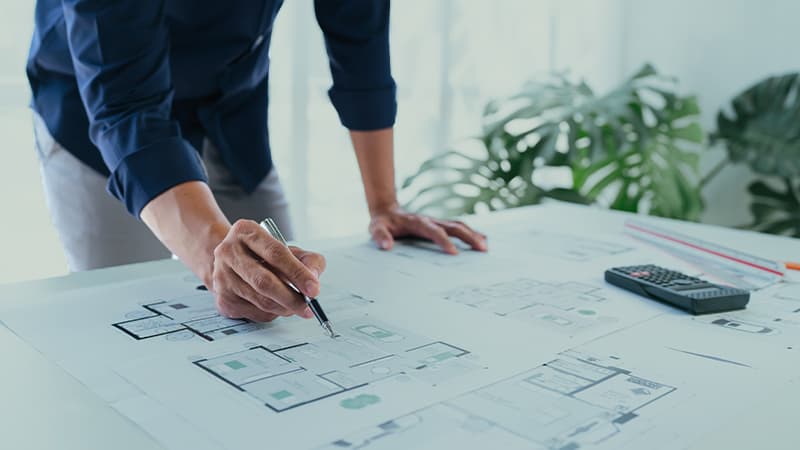Architect Guide to Green Building Materials
Architect Guide to Green Building Materials
Blog Article
Comprehending the Diverse Occupation Paths Available for Aspiring Architect
As an aspiring Architect, you have a globe of career paths awaiting you. Each path provides special challenges and possibilities to use your creative thinking and technological knowledge. Whether you're drawn to standard style or the subtleties of lasting design, there's a particular niche that aligns with your passions. Recognizing these varied options can form your specialist trip, however which direction will you select to check out initially?
Conventional Design: Creating Structures and buildings
Typical design concentrates on designing buildings and structures that mix functionality with aesthetic charm. As you discover this field, you'll value the complex equilibrium in between kind and function. You'll discover to attract motivation from historic styles, integrating aspects like symmetry, materials, and craftsmanship. Your layouts can reflect cultural heritage, showcasing neighborhood customs while fulfilling contemporary demands.
You'll create skills in preparing, model-making, and site evaluation, enabling you to visualize and interact your concepts properly. Involving with clients, you'll need to recognize their vision and translate it right into possible styles.
Furthermore, developing codes and sustainability techniques are essential in your job, ensuring your structures are risk-free and ecologically friendly. As you expand in your career, you'll locate chances in domestic, industrial, or also restoration projects, each offering one-of-a-kind difficulties. Accepting standard style leads the method for a meeting occupation that admires the past while shaping the future.
Urban Planning: Forming Neighborhoods and Public Spaces
As a hopeful Architect, you can play a necessary role as an urban planner, changing how neighborhoods function and interact. By utilizing neighborhood interaction methods, you'll guarantee that homeowners have a voice fit their atmosphere. And also, integrating sustainable style concepts will help create spaces that not only fulfill today's requirements however also protect the future.
Duty of Urban Planners
While many may believe of architects as the sole enthusiasts behind buildings, urban organizers play a necessary function in shaping the wider landscape of communities and public areas. They assess land use, zoning legislations, and neighborhood needs to create lasting atmospheres that enhance lifestyle. By collaborating with various stakeholders, you'll aid develop parks, transport systems, and suburbs that promote social communication and accessibility. Urban coordinators additionally concentrate on environmental considerations, making sure that developments integrate environment-friendly areas and assistance biodiversity. Your experience in spatial style and community dynamics permits you to envision future growth while preserving social heritage. In this vital role, you'll straight influence just how individuals experience their surroundings, making every job a chance for positive change.
Area Involvement Approaches
Efficient area interaction strategies are crucial for urban planners to ensure that the voices of citizens are heard and valued in the planning process. To foster purposeful discussion, you ought to prioritize open forums and workshops where area members can reveal their ideas and worries. By actively incorporating and listening responses, you'll produce areas that reflect the community's requirements, ultimately leading to more sustainable and successful urban environments.
Sustainable Layout Principles
When making metropolitan rooms, incorporating lasting layout principles is critical for developing environments that thrive both environmentally and socially. You need to start by concentrating on power efficiency, using materials that decrease waste and advertise recycling. Think about incorporating green areas, like gardens and parks, to enhance biodiversity and enhance air high quality. Advertising walkability and public transport can reduce dependence on automobiles, cultivating a healthier area.
Designing with water conservation in mind is likewise crucial-- think of rain gardens and permeable surface areas to take care of stormwater. Entailing neighborhood members during the planning procedure guarantees that the spaces you develop satisfy their requirements and motivate social communication. By welcoming these concepts, you'll add to lively, sustainable metropolitan landscapes that benefit everybody.

Landscape Architecture: Producing Sustainable Outdoor Settings
As you check out landscape design, you'll discover necessary layout principles that produce functional and beautiful exterior areas. Sustainable techniques play an important function in ensuring these atmospheres grow while lessening ecological influence. Plus, you'll locate a selection of occupation possibilities that enable you to make a genuine distinction in how people interact with nature.
Layout Concepts in Landscape
Understanding layout principles in landscape design is vital for producing sustainable outside atmospheres that balance with nature. You'll require to contemplate elements like equilibrium, scale, and percentage to ensure your styles really feel natural and welcoming. Furthermore, pay attention to seasonal modifications, developing with materials that match the environments year-round.
Lasting Practices Summary
Lasting methods in landscape style not only concentrate on aesthetics however also prioritize eco-friendly health and source preservation. You can develop rooms that promote soil wellness, such as utilizing natural materials and exercising permaculture concepts. Ultimately, these methods assure your layouts benefit more info both people and the atmosphere for years to come.
Job Opportunities Exploration
With a strong structure in sustainable methods, landscape style supplies a range of job paths that allow you to make a meaningful impact on the setting. Urban coordinators frequently team up with landscape designers to develop eco-friendly rooms in urban settings, enhancing city livability. If you're passionate about education and learning, consider ending up being a landscape style educator, motivating future generations.
Lasting Style: Concentrating On Eco-Friendly Practices
As you discover your career in style, embracing green techniques can set you apart in an affordable area. Sustainable style focuses on developing structures that decrease ecological influence while boosting occupant well-being. By integrating eco-friendly products, energy-efficient systems, and sustainable building strategies, you'll add to a greener future.
Beginning by getting expertise of eco-friendly accreditations like LEED or BREEAM, which can boost your credentials. Think about just how all-natural light, air flow, and thermal efficiency can optimize layout. Collaborate with designers and environmental professionals to introduce services that decrease waste and preserve resources.
Don't forget the value of neighborhood participation-- interesting regional stakeholders can inspire layouts that harmonize with the environment. As clients progressively focus on sustainability, your experience in eco-friendly methods will certainly not just bring in jobs however also meet your enthusiasm for responsible style. Welcome this essential aspect of the career, and view your career thrive.
Historic Conservation: Safeguarding and Recovering Social Heritage
While you commence on your building trip, consider the essential duty of historical preservation in keeping our cultural heritage. This area focuses on the defense and repair of significant buildings, sites, and structures that inform the tales of our past. By taking part in historical conservation, you'll help guard the building legacy that shapes area identity.
As a historical conservation Architect, you'll examine historic value and evaluate the condition of structures. You'll work very closely with chroniclers and conservationists to assure genuine restoration methods are used. This career course enables you to mix imagination with research study, enabling you to develop solutions that value initial materials and craftsmanship.
Your work not only contributes to sustainability by reusing existing structures but additionally promotes a sense of satisfaction within areas. Welcoming this path will assist you come to be a guardian of background, maintaining the stories and appearances that improve our lives.
Inside Style: Enhancing Indoor Spaces
Historic conservation and indoor design both share a commitment to boosting the built environment, yet they concentrate on different facets. While historical preservation highlights maintaining a framework's social and historical value, indoor design zeroes in on maximizing interior areas for performance and aesthetics.
As an aspiring Architect, you'll locate that indoor design enables you to mix imagination with technological abilities. You'll design spaces that not just look great yet likewise advertise comfort and performance. This area entails recognizing exactly how light, shade, and products connect within a room, affecting state of mind and usability.
You'll deal with numerous projects, from domestic homes to industrial offices, guaranteeing that each setting meets the needs of its owners. By focusing on individual experience, you can change insides right into practical and motivating rooms, making a significant influence on exactly how people connect with their environments. Accept the opportunity to enhance interior settings and form the method people work and live.
Industrial Layout: Merging Functionality With Visual Appeals
Industrial layout plays an important function in developing items that effortlessly blend looks with capability, ensuring that what you use everyday is not only aesthetically attractive but also useful. As a hopeful Architect, here you can engage yourself in this area, concentrating on making whatever from furnishings to consumer electronics. Your work involves comprehending individual requirements, products, and manufacturing processes, permitting you to produce cutting-edge options that enhance daily experiences.
In industrial layout, you'll commonly collaborate with makers, engineers, and online marketers, guaranteeing that your styles are not just attractive yet also feasible. This profession path provides a dynamic setting where creativity meets practicality, making it a fulfilling choice for architects interested in forming the items of tomorrow.
Often Asked Concerns
What Educational Certifications Do I Need to Come To Be an Architect?
To end up being a designer, you'll require an expert degree in style, typically a Bachelor's or Master's. Additionally, you'll need to finish a teaching fellowship and pass the Architect Registration Exam to exercise legitimately.
Exist Accreditation Needs for Various Building Job Paths?
Yes, there're accreditation demands for different building courses. Architect. You'll need to pass tests, total teaching fellowships, and sometimes pursue specialized training, relying on your picked focus, like landscape style, metropolitan layout, or historical preservation
What Software Program Skills Are Essential for Designers Today?

Just How Can I Gain Practical Experience While Researching Architecture?
You can obtain practical experience by interning at architectural companies, joining design competitions, offering for neighborhood jobs, or working together with schoolmates on real-world assignments. These possibilities enhance your skills and build important links in the market.
What Work Opportunities Exist Outside Standard Style Firms?
You can check out various job chances outside conventional architecture companies, like urban planning, interior here decoration, landscape style, building monitoring, property growth, or perhaps duties in sustainability consulting. Each offers one-of-a-kind obstacles and benefits.
Whether you're attracted to traditional style or the nuances of sustainable layout, there's a niche that lines up with your interests.When making city spaces, incorporating lasting design principles is vital for producing settings that flourish both environmentally and socially.As you explore landscape design, you'll discover important style principles that develop functional and attractive exterior spaces.Comprehending layout concepts in landscape style is crucial for creating lasting outdoor settings that harmonize with nature.In commercial style, you'll commonly work together with designers, online marketers, and makers, making certain that your layouts are not just attractive yet additionally viable.
Report this page